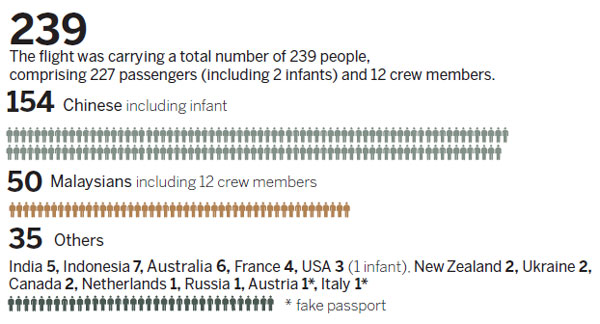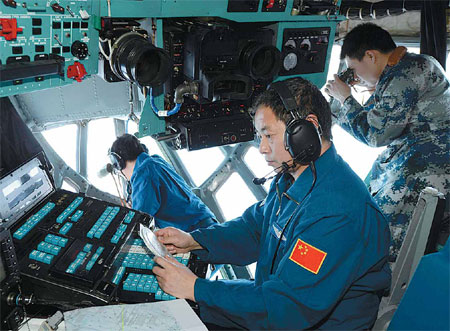We will not give up search, Li vows
Updated: 2014-03-14 12:48
By Peng Yining in Kuala Lumpur and Liu Baijia and He Na in Beijing (China Daily Europe)
|
|||||||||||
|
Crew members fly a Chinese PLA air force aircraft on March 12 over the area above Malaysian seas where the missing Malaysia Airlines flight MH370 last made contact. Shen Ling / Xinhua |
International hunt for missing airliner continues after fruitless six-day search
Premier Li Keqiang has vowed that China will not give up the search for clues to the fate of the missing Malaysia Airlines flight MH370 carrying 239 people, including 154 Chinese.
"The families are very anxious, and we are anxiously waiting for information, too," he said, answering the first question at a news conference after the close of the second session of the 12th National People's Congress.
"China will never compromise on airline security," he said. "It is a top priority because people's lives are involved."
The Malaysian Airlines Boeing 777-200 aircraft, carrying 227 passengers and 12 crew and heading for Beijing, has been missing for almost a week after taking off from Kuala Lumpur.
After a multinational air and sea hunt, all that had been produced were numerous tantalizing and often contradictory clues but few firm answers.
At least 12 countries including Malaysia, China, Vietnam and the United States had deployed nearly 40 aircraft and more than 40 ships in possible crash areas in the South China Sea and the Strait of Malacca.
Li said China had initiated an all-round research emergency response. It dispatched eight ships and five aircraft and one more ship was on the way.
He talked with the captain of a rescue ship on March 12 and urged the Chinese rescue team to step up its efforts.
China had mobilized 10 satellites in the search, he said. Some of these found three floating objects suspected of being related to the missing flight, but aircraft dispatched by Malaysia to investigate found no debris.
Li said the rescue and search effort was an international one and China was playing its part. China urged all those involved to improve coordination and handle everything related to the families of the passengers appropriately, he said.
On March 13 the Wall Street Journal, quoting two people familiar with the matter, said US investigators believed the aircraft had flown for about four hours after it reached its last confirmed location. This raised the possibility that it had flown on for hundreds of more kilometers in conditions that remain murky.
Aviation investigators and national security officials believe the aircraft flew for a total of five hours, based on data automatically downloaded and sent to the ground from the Boeing Co's 777 engines as part of a routine maintenance and monitoring program, the report said.
Richard Wray, director of external communications of Rolls-Royce, said: "We are currently not in a position to confirm or deny the Wall Street Journal report because flight data is supposed to be confidential until such time as the air accident investigator says otherwise. We are continuing to support Malaysia Airlines in its investigation."
On suggestions that Malaysia's military held back information regarding its radar records, Li Jiaxiang, head of the Civil Aviation Administration of China, said: "We don't have any evidence to prove that, but we call on Malaysia to provide comprehensive, accurate information to avoid authoritative information being misrepresented."
The head of the National Institute of South China Sea Studies, Wu Shicun, told 21st Century Business Herald: "With the scope of the search extending to the Strait of Malacca, there will be more challenges."
The strait is under the jurisdiction of Malaysia, Indonesia and Singapore. Foreign warships are not allowed to enter without the consent of all three countries.
"They are all strategic partners of the United States," Wu said. "If they have allowed US ships to search the area, they have no reason to refuse China warships to do so, too. Two thirds of the aircraft's passengers are Chinese. But coordinating all of this is likely to be very complicated."
While China has been using satellite remote sensing to search for the missing aircraft, experts said this did not make the task any less arduous.
Information from the satellites is process by the Institute of Remote Sensing and Digital Earth of the Chinese Academy of Sciences.
"When we search for missing planes or boats we can narrow down the range gradually as we get more and more information," said Yan Dongmei, director of the science and technology department of the institute. "But in this case the search area has expanded continuously as more information has come in, which is one reason for the search taking so long."
On March 9, scientists from the institute found oil slicks in the water where, at that time, the aircraft was said to have gone missing. Later analysis ruled out the slicks as being connected with the aircraft.
On March 12, the State Administration of Science, Technology and Industry for National Defense said that three objects had been found floating in the water at the latitude of 6.7 degrees north and the longitude of 105.63 degrees east, spread across an area with a radius of 20 kilometers.
"Satellite sensing can only provide material for rescuers to check," Yan said.
The usefulness of information relayed by numerous satellites over five days was limited because the images captured over a target area pertained to a particular point in time, he said.
"The noise from sea water also influences satellite images. And they can only relay pictures of objects floating on the water, with few clues about anything that has sunk."
Malaysia Airlines said that to respect the passengers and crew of the missing aircraft, the flight number MH370 would be retired and replaced by MH318 from March 14.
Contact writers through pengyining@chinadaily.com.cn

(China Daily European Weekly 03/14/2014 page3)
Today's Top News
US rejects Crimean vote, citing sanctions
Probe focues on missing jet's pilots
Source: Vodafone to buy Spain's Ono
Crimea votes to join Russia
Alibaba opts for IPO in US
Stronger police presence urged
Crimea kicks off referendum
G8 prepares expulsion of Russia
Hot Topics
Lunar probe , China growth forecasts, Emission rules get tougher, China seen through 'colored lens', International board,
Editor's Picks

|

|

|

|

|

|






